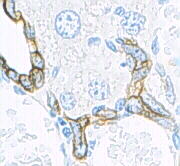| Keratin disease | |
|---|---|
| Other names | Keratinopathy |
 | |
| Keratin (high molecular weight) in bile duct cell and oval cells of mouse liver. | |
| Specialty | Dermatology |
A keratin disease is a genetic disorder of one of the keratin genes.[ citation needed ] An example is monilethrix. [1] The first to be identified was epidermolysis bullosa simplex. [2] [3]